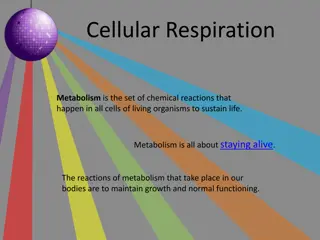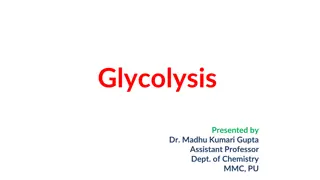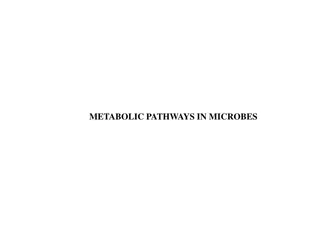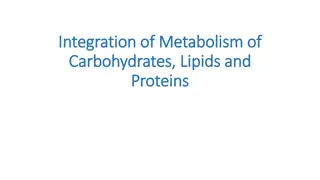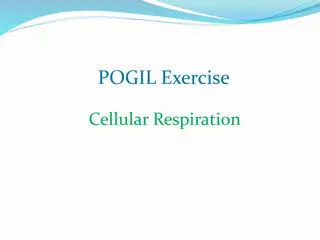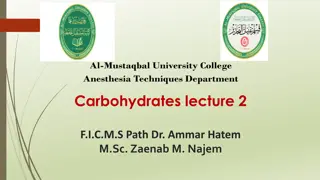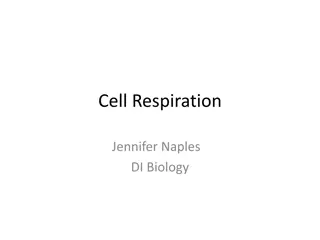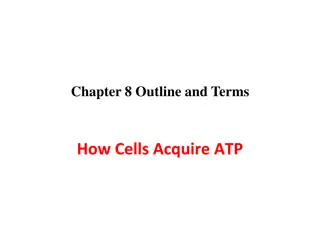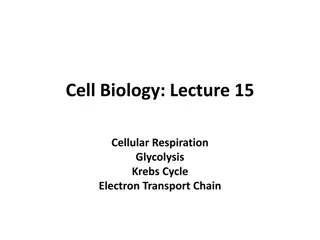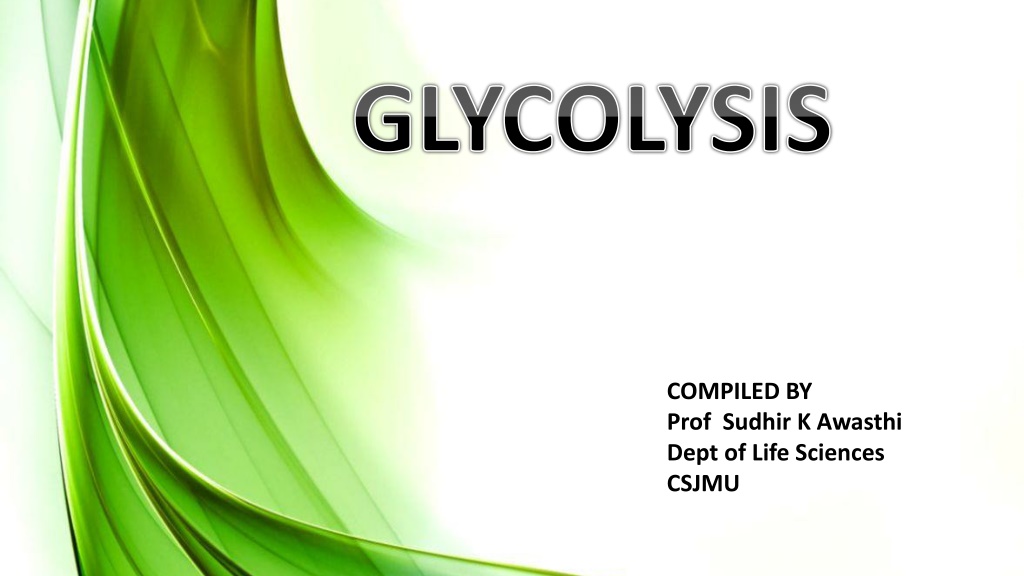
Understanding Glycolysis and its Role in Energy Production
Glycolysis is a fundamental metabolic pathway that breaks down glucose to produce energy in the form of ATP. This process, compiled by Prof. Sudhir K. Awasthi, plays a key role in energy generation at the cellular level, involving various enzymes and reactions essential for glucose metabolism. Explore the significance of glycolysis in energy production and its connection to other metabolic pathways for energy utilization and storage.
Download Presentation

Please find below an Image/Link to download the presentation.
The content on the website is provided AS IS for your information and personal use only. It may not be sold, licensed, or shared on other websites without obtaining consent from the author. If you encounter any issues during the download, it is possible that the publisher has removed the file from their server.
You are allowed to download the files provided on this website for personal or commercial use, subject to the condition that they are used lawfully. All files are the property of their respective owners.
The content on the website is provided AS IS for your information and personal use only. It may not be sold, licensed, or shared on other websites without obtaining consent from the author.
E N D
Presentation Transcript
GLYCOLYSIS COMPILED BY Prof Sudhir K Awasthi Dept of Life Sciences CSJMU
Glycolysis Glucose is the body s most readily available source of energy. After digestive processes break polysaccharides down into monosaccharides, including glucose, the monosaccharides are transported across the wall of thesmall intestine and into the circulatory system, which transports them to theliver. In the liver, hepatocytes either pass the glucose on through the circulatory system or store excess glucose as glycogen. Cells in the body take up the circulating glucose in response to insulin and, through a series of reactions called glycolysis, transfer some of the energy in glucose to ADP to formATP. The last step in glycolysis produces the productpyruvate.
Glucose + 2ATP + 2NAD + 4ADP + 2P Pyruvate + 4ATP +2N One glucose molecule breaks down into two pyruvate molecules, and creates two net ATP molecules and two NADH molecules byglycolysis. Therefore, glycolysis generates energy for the cell and creates pyruvate molecules that can be processed further through the aerobic Krebs cycle (also called thecitric acid cycle or tricarboxylic acid cycle); converted into lactic acid or alcohol (in yeast) by fermentation; or used later for the synthesis of glucose through gluconeogenesis.
Glycolysis include the enzymes responsible for the reactions. When glucose enters a cell, the enzyme hexokinase (or glucokinase, in theliver) rapidly adds a phosphate to convert it intoglucose-6-phosphate. A kinase is a type of enzyme that adds a phosphate molecule to a substrate (inthis case, glucose, but it can be true of other moleculesalso). This conversion step requires one ATP and essentially traps the glucose in thecell, preventing it from passing back through the plasma membrane, thus allowing glycolysis to proceed. It also functions to maintain a concentration gradient with higher glucose levels inthe blood than in the tissues. By establishing this concentration gradient, the glucose in the blood will be ableto ow from an area of high concentration (the blood) into an area of low concentration (the tissues) to be either used or stored.
Hexokinase is found in nearly every tissue in the body. Glucokinase, on the other hand, is expressed in tissues that are active when bloodglucose levels are high, such as the liver. Hexokinase has a higher a nity for glucose than glucokinase and therefore is ableto convert glucose at a faster rate than glucokinase. This is important when levels of glucose are very low in the body, as it allows glucose to travel preferentially to those tissues that require itmore. the enzyme glucose-6- phosphate isomerase converts glucose-6-phosphate intofructose-6- phosphate. Like glucose, fructose is also a six carbon-containingsugar. The enzyme phosphofructokinase-1 then adds one more phosphate to convertfructose-6- phosphate into fructose-1-6-bisphosphate, another six-carbon sugar, using another ATP molecule. Aldolase then breaks down this fructose-1-6-bisphosphate into two three-carbon molecules, glyceraldehyde-3-phosphate and dihydroxyacetonephosphate.
The triosephosphate isomerase enzyme then converts dihydroxyacetone phosphateinto a second glyceraldehyde-3-phosphatemolecule. Therefore, by the end of this chemical- priming or energy-consuming phase, one glucose molecule is broken down into two glyceraldehyde-3- phosphate molecules. The second phase of glycolysis, the energy-yielding phase, creates the energy thatis the product of glycolysis. Glyceraldehyde-3-phosphate dehydrogenase converts each three-carbon glyceraldehyde-3- phosphate produced during the energy-consuming phase into1,3- bisphosphoglycerate. This reaction releases an electron that is then picked up by NAD+ to create anNADH molecule. NADH is a high-energy molecule, like ATP, but unlike ATP, it is not used as energy currency by the cell.
Because there are two glyceraldehyde-3-phosphate molecules, twoNADH molecules are synthesized during this step. Each 1,3-bisphosphoglycerate is subsequently dephosphorylated (i.e., a phosphate is removed) by phosphoglycerate kinase into 3-phosphoglycerate. Each phosphate released in this reaction can convert one molecule of ADPinto one highenergy ATP molecule, resulting in a gain of two ATPmolecules. The enzyme phosphoglycerate mutase then converts the 3-phosphoglycerate molecules into 2-phosphoglycerate. The enolase enzyme then acts upon the 2-phosphoglycerate moleculesto convert them into phosphoenolpyruvatemolecules. The last step of glycolysis involves the dephosphorylation of the two phosphoenolpyruvate molecules by pyruvate kinase to create twopyruvate molecules and two ATPmolecules.
Anaerobic Respiration When oxygen is limited or absent, pyruvate enters an anaerobicpathway. In these reactions, pyruvate can be converted into lacticacid. In addition to generating an additional ATP, this pathway serves to keep thepyruvate concentration low so glycolysis continues, and it oxidizes NADH into the NAD+ needed by glycolysis. In this reaction, lactic acid replaces oxygen as the anaerobicrespiration. This is an effective pathway of ATP production for short periods of time,ranging from seconds to a few minutes. The lactic acid produced diffuses into the plasma and is carried to the liver, where itis converted back into pyruvate or glucose via the Coricycle. Similarly, when a person exercises, muscles use ATP faster than oxygen can be delivered to them. They depend on glycolysis and lactic acid production for rapidATP production.Aerobic.
Aerobic Respiration In the presence of oxygen, pyruvate can enter the Krebs cycle where additional energy is extracted as electrons are transferred from the pyruvate to thereceptors NAD+, GDP, and FAD, with carbon dioxide being a waste product . The NADH and FADH2 pass electrons on to the electron transport chain, which uses the transferred energy to produceATP. As the terminal step in the electron transport chain, oxygen is the terminalelectron acceptor and creates water inside the mitochondria.
Gluconeogenesis Gluconeogenesis is the synthesis of new glucose molecules from pyruvate, lactate, glycerol, or the amino acids alanine or glutamine. This process takes place primarily in the liver during periods of low glucose,that is, under conditions of fasting, starvation, and low carbohydratediets. So, the question can be raised as to why the body would create something it has just spent a fair amount of effort to break down? Certain key organs, including the brain, can use only glucose as an energy source; therefore, it is essential that the body maintain a minimum blood glucose concentration. When the blood glucose concentration falls below that certain point, newglucose is synthesized by the liver to raise the blood concentration tonormal.
Gluconeogenesis is not simply the reverse of glycolysis. There aresome important differences . Pyruvate is a common starting material for gluconeogenesis. First, thepyruvate is converted into oxaloacetate. Oxaloacetate then serves as a substrate for the enzymephosphoenolpyruvate carboxykinase (PEPCK), which transforms oxaloacetate into phosphoenolpyruvate (PEP). From this step, gluconeogenesis is nearly the reverse of glycolysis. PEPis converted back into 2-phosphoglycerate, which is converted into3- phosphoglycerate. Then, 3-phosphoglycerate is converted into 1,3 bisphosphoglycerate andthen into glyceraldehyde-3-phosphate. Two molecules of glyceraldehyde-3-phosphate then combine to form fructose- 1-6-bisphosphate, which is converted into fructose 6-phosphate and theninto glucose-6-phosphate.
AGING AND THE BODYS METABOLIC RATE The human body s metabolic rate decreases nearly 2 percent per decade after age30. Changes in body composition, including reduced lean muscle mass, aremostly responsible for this decrease. The most dramatic loss of muscle mass, and consequential decline in metabolic rate, occurs between 50 and 70 years of age. Loss of muscle mass is the equivalent of reduced strength, which tends to inhibitseniors from engaging in sufficient physical activity. This results in a positive-feedback system where the reduced physical activity leads to even more muscle loss, further reducing metabolism. There are several things that can be done to help prevent general declines inmetabolism and to fight back against the cyclic nature of thesedeclines. These include eating breakfast, eating small meals frequently, consuming plenty of lean protein, drinking water to remain hydrated, exercising (including strength training), and getting enough sleep.
These measures can help keep energy levels from dropping and curb the urgefor increased calorie consumption from excessivesnacking. While these strategies are not guaranteed to maintain metabolism, they dohelp prevent muscle loss and may increase energy levels. Some experts also suggest avoiding sugar, which can lead to excess fat storage. Spicy foods and green tea might also be beneficial. Because stress activates cortisol release, and cortisol slows metabolism, avoiding stress, or at least practicing relaxation techniques, can alsohelp.
References Biochemistry by J.M Berg, J.L. Tymo Czko & Lubert Stryer(2011) Textbook of Biochemistry by Damodaran M. Vasudevan & Srikumari (2015) Principles of Biochemistry by A.L. Lehninger , D.L. Nelson & M.M. Cox (2016) Basic Medical Biochemistry; A Clinical approach by Alisa Peet & Michael Lieberman (2017) Harper s Illustrated Biochemistry by V.W. Rodwell, D.A. Bender (2018)


